JEEP PATRIOT 2020 Owner handbook (in English)
Manufacturer: JEEP, Model Year: 2020, Model line: PATRIOT, Model: JEEP PATRIOT 2020Pages: 332, PDF Size: 1.99 MB
Page 181 of 332
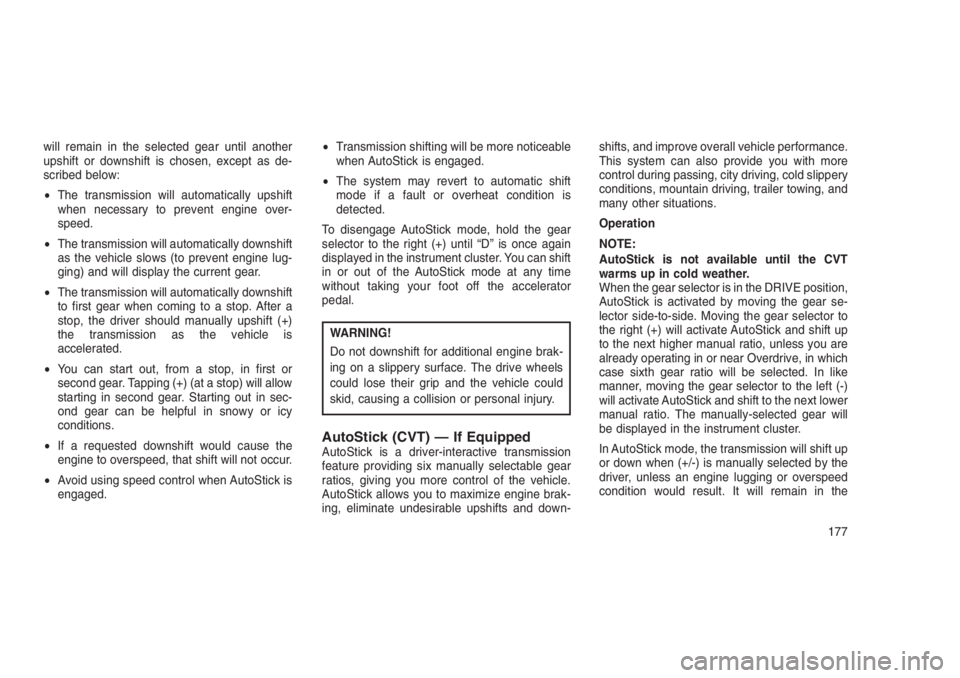
will remain in the selected gear until another
upshift or downshift is chosen, except as de-
scribed below:
•The transmission will automatically upshift
when necessary to prevent engine over-
speed.
•The transmission will automatically downshift
as the vehicle slows (to prevent engine lug-
ging) and will display the current gear.
•The transmission will automatically downshift
to first gear when coming to a stop. After a
stop, the driver should manually upshift (+)
the transmission as the vehicle is
accelerated.
•You can start out, from a stop, in first or
second gear. Tapping (+) (at a stop) will allow
starting in second gear. Starting out in sec-
ond gear can be helpful in snowy or icy
conditions.
•If a requested downshift would cause the
engine to overspeed, that shift will not occur.
•Avoid using speed control when AutoStick is
engaged.•Transmission shifting will be more noticeable
when AutoStick is engaged.
•The system may revert to automatic shift
mode if a fault or overheat condition is
detected.
To disengage AutoStick mode, hold the gear
selector to the right (+) until “D” is once again
displayed in the instrument cluster. You can shift
in or out of the AutoStick mode at any time
without taking your foot off the accelerator
pedal.
WARNING!
Do not downshift for additional engine brak-
ing on a slippery surface. The drive wheels
could lose their grip and the vehicle could
skid, causing a collision or personal injury.
AutoStick (CVT) — If EquippedAutoStick is a driver-interactive transmission
feature providing six manually selectable gear
ratios, giving you more control of the vehicle.
AutoStick allows you to maximize engine brak-
ing, eliminate undesirable upshifts and down-shifts, and improve overall vehicle performance.
This system can also provide you with more
control during passing, city driving, cold slippery
conditions, mountain driving, trailer towing, and
many other situations.
Operation
NOTE:
AutoStick is not available until the CVT
warms up in cold weather.
When the gear selector is in the DRIVE position,
AutoStick is activated by moving the gear se-
lector side-to-side. Moving the gear selector to
the right (+) will activate AutoStick and shift up
to the next higher manual ratio, unless you are
already operating in or near Overdrive, in which
case sixth gear ratio will be selected. In like
manner, moving the gear selector to the left (-)
will activate AutoStick and shift to the next lower
manual ratio. The manually-selected gear will
be displayed in the instrument cluster.
In AutoStick mode, the transmission will shift up
or down when (+/-) is manually selected by the
driver, unless an engine lugging or overspeed
condition would result. It will remain in the
177
Page 182 of 332
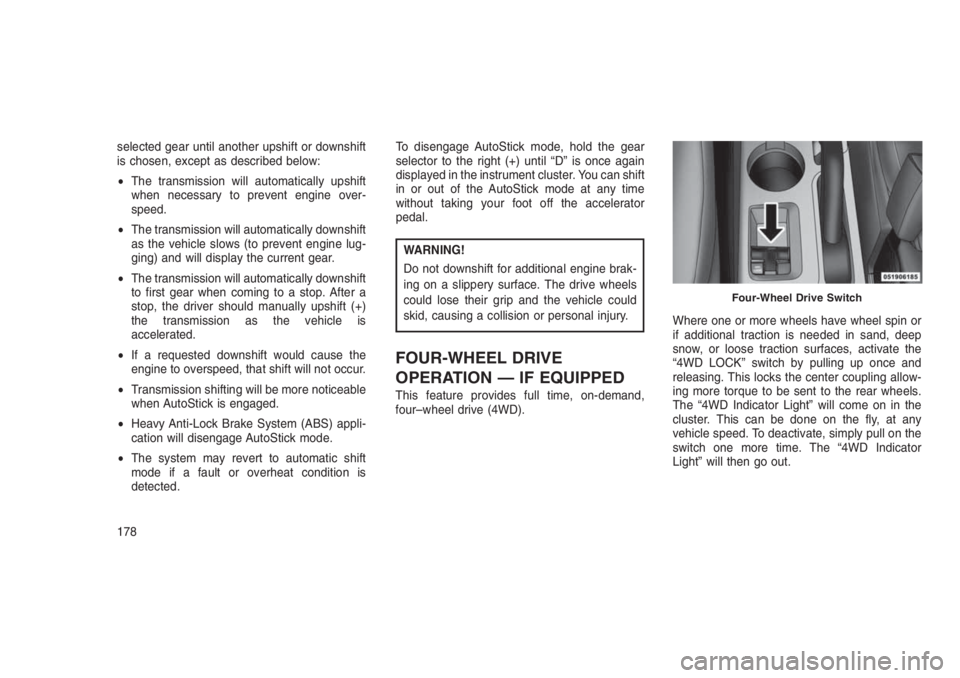
selected gear until another upshift or downshift
is chosen, except as described below:
•The transmission will automatically upshift
when necessary to prevent engine over-
speed.
•The transmission will automatically downshift
as the vehicle slows (to prevent engine lug-
ging) and will display the current gear.
•The transmission will automatically downshift
to first gear when coming to a stop. After a
stop, the driver should manually upshift (+)
the transmission as the vehicle is
accelerated.
•If a requested downshift would cause the
engine to overspeed, that shift will not occur.
•Transmission shifting will be more noticeable
when AutoStick is engaged.
•Heavy Anti-Lock Brake System (ABS) appli-
cation will disengage AutoStick mode.
•The system may revert to automatic shift
mode if a fault or overheat condition is
detected.To disengage AutoStick mode, hold the gear
selector to the right (+) until “D” is once again
displayed in the instrument cluster. You can shift
in or out of the AutoStick mode at any time
without taking your foot off the accelerator
pedal.
WARNING!
Do not downshift for additional engine brak-
ing on a slippery surface. The drive wheels
could lose their grip and the vehicle could
skid, causing a collision or personal injury.
FOUR-WHEEL DRIVE
OPERATION — IF EQUIPPED
This feature provides full time, on-demand,
four–wheel drive (4WD).Where one or more wheels have wheel spin or
if additional traction is needed in sand, deep
snow, or loose traction surfaces, activate the
“4WD LOCK” switch by pulling up once and
releasing. This locks the center coupling allow-
ing more torque to be sent to the rear wheels.
The “4WD Indicator Light” will come on in the
cluster. This can be done on the fly, at any
vehicle speed. To deactivate, simply pull on the
switch one more time. The “4WD Indicator
Light” will then go out.
Four-Wheel Drive Switch
178
Page 183 of 332
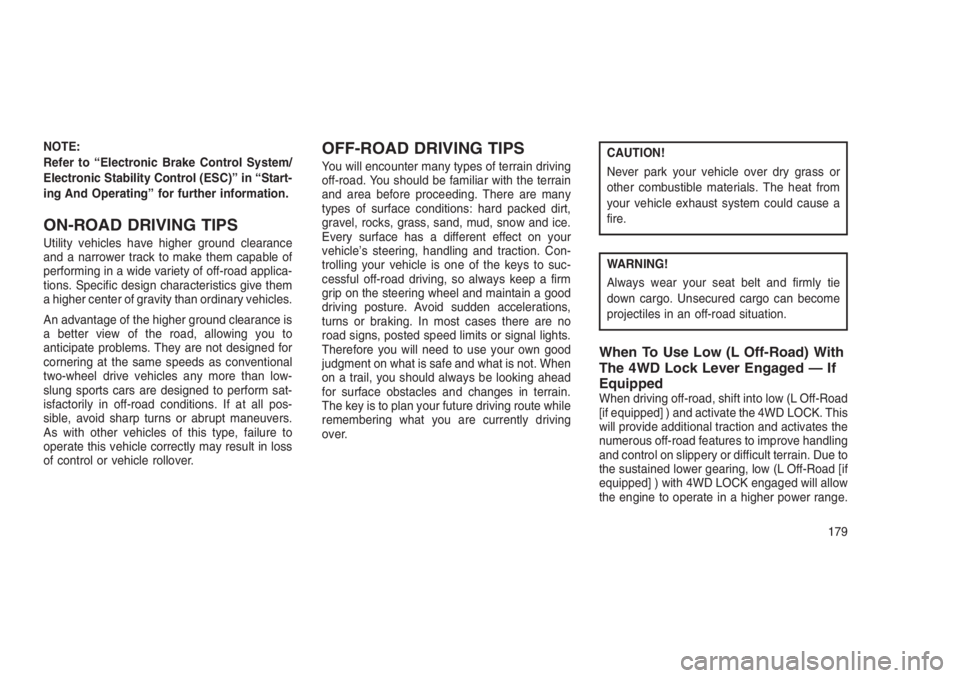
NOTE:
Refer to “Electronic Brake Control System/
Electronic Stability Control (ESC)” in “Start-
ing And Operating” for further information.
ON-ROAD DRIVING TIPS
Utility vehicles have higher ground clearance
and a narrower track to make them capable of
performing in a wide variety of off-road applica-
tions. Specific design characteristics give them
a higher center of gravity than ordinary vehicles.
An advantage of the higher ground clearance is
a better view of the road, allowing you to
anticipate problems. They are not designed for
cornering at the same speeds as conventional
two-wheel drive vehicles any more than low-
slung sports cars are designed to perform sat-
isfactorily in off-road conditions. If at all pos-
sible, avoid sharp turns or abrupt maneuvers.
As with other vehicles of this type, failure to
operate this vehicle correctly may result in loss
of control or vehicle rollover.
OFF-ROAD DRIVING TIPS
You will encounter many types of terrain driving
off-road. You should be familiar with the terrain
and area before proceeding. There are many
types of surface conditions: hard packed dirt,
gravel, rocks, grass, sand, mud, snow and ice.
Every surface has a different effect on your
vehicle’s steering, handling and traction. Con-
trolling your vehicle is one of the keys to suc-
cessful off-road driving, so always keep a firm
grip on the steering wheel and maintain a good
driving posture. Avoid sudden accelerations,
turns or braking. In most cases there are no
road signs, posted speed limits or signal lights.
Therefore you will need to use your own good
judgment on what is safe and what is not. When
on a trail, you should always be looking ahead
for surface obstacles and changes in terrain.
The key is to plan your future driving route while
remembering what you are currently driving
over.CAUTION!
Never park your vehicle over dry grass or
other combustible materials. The heat from
your vehicle exhaust system could cause a
fire.
WARNING!
Always wear your seat belt and firmly tie
down cargo. Unsecured cargo can become
projectiles in an off-road situation.
When To Use Low (L Off-Road) With
The 4WD Lock Lever Engaged — If
Equipped
When driving off-road, shift into low (L Off-Road
[if equipped] ) and activate the 4WD LOCK. This
will provide additional traction and activates the
numerous off-road features to improve handling
and control on slippery or difficult terrain. Due to
the sustained lower gearing, low (L Off-Road [if
equipped] ) with 4WD LOCK engaged will allow
the engine to operate in a higher power range.
179
Page 184 of 332

This will allow you to cross over obstacles and
descend hills, with improved control and less
effort.
NOTE:
For maximum off-road performance, pre-
mium fuel is recommended. While the ve-
hicle will operate on regular fuel when in L
Off-Road mode (if equipped), the engine has
been calibrated for maximum performance
using premium fuel.
Driving In Snow, Mud And SandThere is a drastic reduction in traction when
driving in snow, mud or sand. The vehicle will be
less responsive to steering, acceleration and
braking inputs. Therefore, you should acceler-
ate slowly, leave greater stopping distances and
avoid abrupt vehicle maneuvers. You want to
keep a slow constant steady pace. The key is to
maintain the vehicle’s momentum.
Snow
In heavy snow or for additional control and
traction at slower speeds, activate the 4WD
LOCK and shift the transaxle to low (L Off-Road
[if equipped] ) if necessary. Do not shift to a
lower gear than necessary to maintain head-way. Over-revving the engine can spin the
wheels and traction will be lost. If you start to
slow to a stop, try turning your steering wheel no
more than a 1/4 turn quickly back and forth,
while still applying throttle. This will allow the
tires to get a fresh"bite"and help maintain your
momentum.
CAUTION!
On icy or slippery roads, do not downshift at
high engine RPM’s or vehicle speeds be-
cause engine braking may cause skidding
and loss of control.
Mud
Deep mud creates a great deal of suction
around the tires and is very difficult to get
through. You should use low (L Off-Road [if
equipped] ) with the 4WD LOCK engaged and
maintain your momentum. If you start to slow to
a stop, try turning your steering wheel no more
than a 1/4 turn quickly back and forth for
additional traction. Mud holes pose an in-
creased threat of vehicle damage and getting
stuck. They are normally full of debris fromprevious vehicles getting stuck. As a good prac-
tice before entering any mud hole, get out and
determine how deep it is, if there are any hidden
obstacles and if the vehicle can be safely recov-
ered if stuck.
Sand
Soft sand is very difficult to travel through with
full tire pressure. When crossing soft sandy
spots in a trail maintain your vehicle’s momen-
tum and do not stop. The key to driving in soft
sand is using the appropriate tire pressure,
accelerating slowly, avoiding abrupt maneuvers
and maintaining the vehicle’s momentum. If you
are going to be driving on large soft sandy areas
or dunes, reduce your tire pressure to a mini-
mum of 15 psi (103 kPa) to allow for a greater
tire surface area. You should use low (L Off-
Road [if equipped] ) with the 4WD LOCK en-
gaged and ESC turned off. Reduced tire pres-
sure will drastically improve your traction and
handling, while driving on the soft sand, but you
must return the tires to normal air pressure
before driving on pavement or other hard sur-
faces. Be sure you have a way to reinflate the
tires prior to reducing the pressure.
180
Page 185 of 332
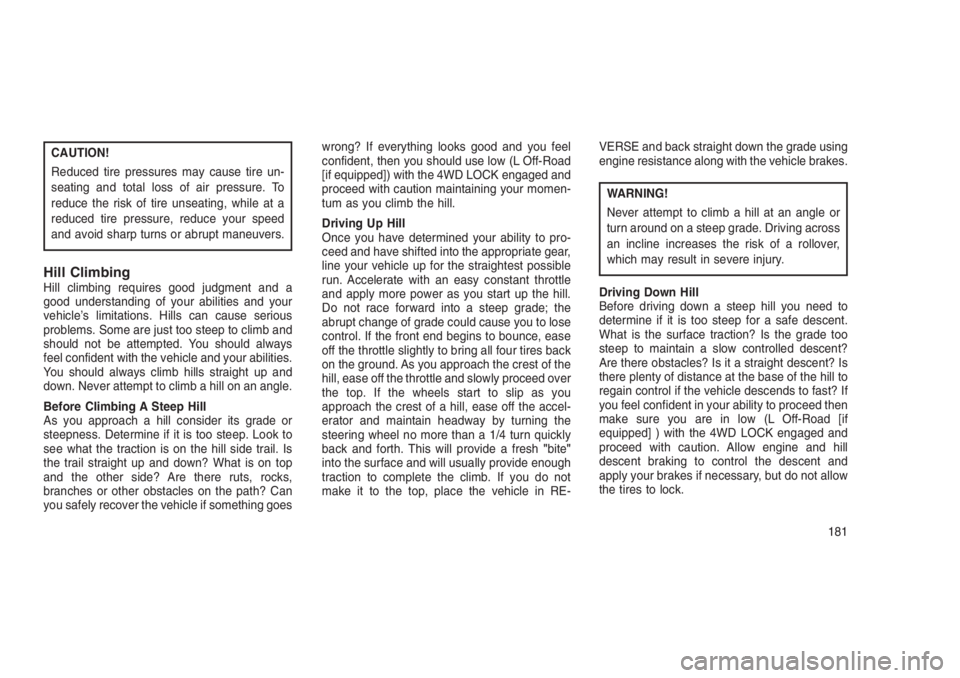
CAUTION!
Reduced tire pressures may cause tire un-
seating and total loss of air pressure. To
reduce the risk of tire unseating, while at a
reduced tire pressure, reduce your speed
and avoid sharp turns or abrupt maneuvers.
Hill ClimbingHill climbing requires good judgment and a
good understanding of your abilities and your
vehicle’s limitations. Hills can cause serious
problems. Some are just too steep to climb and
should not be attempted. You should always
feel confident with the vehicle and your abilities.
You should always climb hills straight up and
down. Never attempt to climb a hill on an angle.
Before Climbing A Steep Hill
As you approach a hill consider its grade or
steepness. Determine if it is too steep. Look to
see what the traction is on the hill side trail. Is
the trail straight up and down? What is on top
and the other side? Are there ruts, rocks,
branches or other obstacles on the path? Can
you safely recover the vehicle if something goeswrong? If everything looks good and you feel
confident, then you should use low (L Off-Road
[if equipped]) with the 4WD LOCK engaged and
proceed with caution maintaining your momen-
tum as you climb the hill.
Driving Up Hill
Once you have determined your ability to pro-
ceed and have shifted into the appropriate gear,
line your vehicle up for the straightest possible
run. Accelerate with an easy constant throttle
and apply more power as you start up the hill.
Do not race forward into a steep grade; the
abrupt change of grade could cause you to lose
control. If the front end begins to bounce, ease
off the throttle slightly to bring all four tires back
on the ground. As you approach the crest of the
hill, ease off the throttle and slowly proceed over
the top. If the wheels start to slip as you
approach the crest of a hill, ease off the accel-
erator and maintain headway by turning the
steering wheel no more than a 1/4 turn quickly
back and forth. This will provide a fresh"bite"
into the surface and will usually provide enough
traction to complete the climb. If you do not
make it to the top, place the vehicle in RE-VERSE and back straight down the grade using
engine resistance along with the vehicle brakes.
WARNING!
Never attempt to climb a hill at an angle or
turn around on a steep grade. Driving across
an incline increases the risk of a rollover,
which may result in severe injury.
Driving Down Hill
Before driving down a steep hill you need to
determine if it is too steep for a safe descent.
What is the surface traction? Is the grade too
steep to maintain a slow controlled descent?
Are there obstacles? Is it a straight descent? Is
there plenty of distance at the base of the hill to
regain control if the vehicle descends to fast? If
you feel confident in your ability to proceed then
make sure you are in low (L Off-Road [if
equipped] ) with the 4WD LOCK engaged and
proceed with caution. Allow engine and hill
descent braking to control the descent and
apply your brakes if necessary, but do not allow
the tires to lock.
181
Page 186 of 332
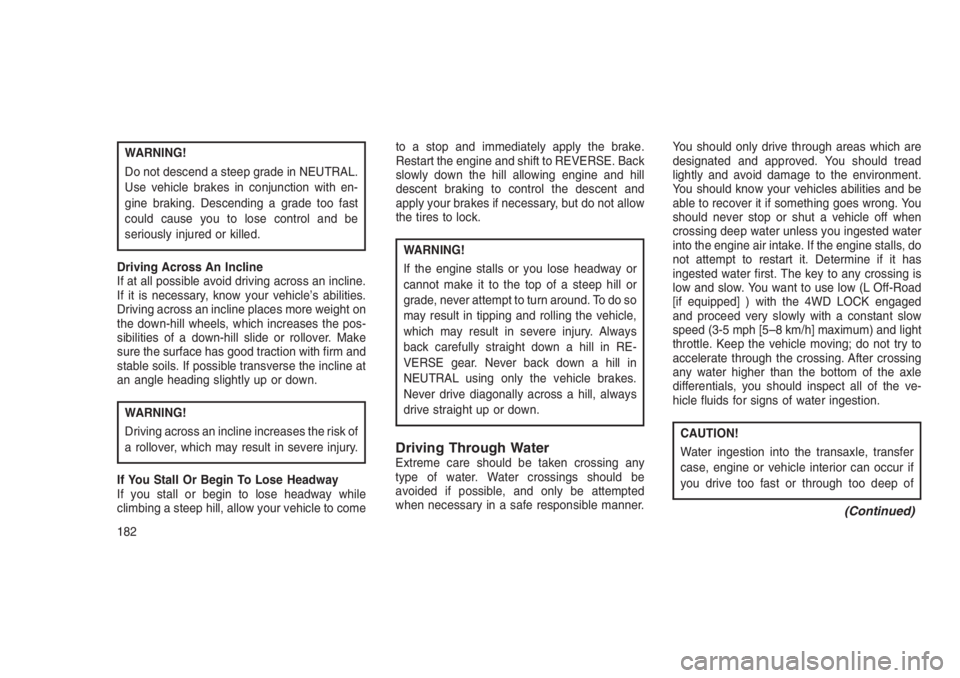
WARNING!
Do not descend a steep grade in NEUTRAL.
Use vehicle brakes in conjunction with en-
gine braking. Descending a grade too fast
could cause you to lose control and be
seriously injured or killed.
Driving Across An Incline
If at all possible avoid driving across an incline.
If it is necessary, know your vehicle’s abilities.
Driving across an incline places more weight on
the down-hill wheels, which increases the pos-
sibilities of a down-hill slide or rollover. Make
sure the surface has good traction with firm and
stable soils. If possible transverse the incline at
an angle heading slightly up or down.
WARNING!
Driving across an incline increases the risk of
a rollover, which may result in severe injury.
If You Stall Or Begin To Lose Headway
If you stall or begin to lose headway while
climbing a steep hill, allow your vehicle to cometo a stop and immediately apply the brake.
Restart the engine and shift to REVERSE. Back
slowly down the hill allowing engine and hill
descent braking to control the descent and
apply your brakes if necessary, but do not allow
the tires to lock.
WARNING!
If the engine stalls or you lose headway or
cannot make it to the top of a steep hill or
grade, never attempt to turn around. To do so
may result in tipping and rolling the vehicle,
which may result in severe injury. Always
back carefully straight down a hill in RE-
VERSE gear. Never back down a hill in
NEUTRAL using only the vehicle brakes.
Never drive diagonally across a hill, always
drive straight up or down.
Driving Through WaterExtreme care should be taken crossing any
type of water. Water crossings should be
avoided if possible, and only be attempted
when necessary in a safe responsible manner.You should only drive through areas which are
designated and approved. You should tread
lightly and avoid damage to the environment.
You should know your vehicles abilities and be
able to recover it if something goes wrong. You
should never stop or shut a vehicle off when
crossing deep water unless you ingested water
into the engine air intake. If the engine stalls, do
not attempt to restart it. Determine if it has
ingested water first. The key to any crossing is
low and slow. You want to use low (L Off-Road
[if equipped] ) with the 4WD LOCK engaged
and proceed very slowly with a constant slow
speed (3-5 mph [5–8 km/h] maximum) and light
throttle. Keep the vehicle moving; do not try to
accelerate through the crossing. After crossing
any water higher than the bottom of the axle
differentials, you should inspect all of the ve-
hicle fluids for signs of water ingestion.
CAUTION!
Water ingestion into the transaxle, transfer
case, engine or vehicle interior can occur if
you drive too fast or through too deep of
(Continued)
182
Page 187 of 332
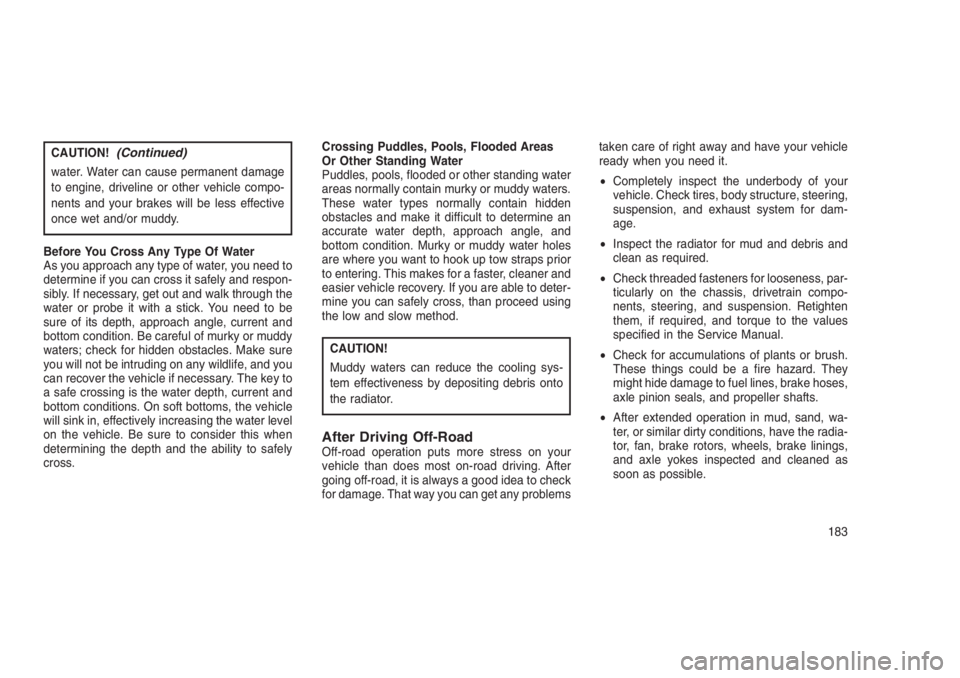
CAUTION!(Continued)
water. Water can cause permanent damage
to engine, driveline or other vehicle compo-
nents and your brakes will be less effective
once wet and/or muddy.
Before You Cross Any Type Of Water
As you approach any type of water, you need to
determine if you can cross it safely and respon-
sibly. If necessary, get out and walk through the
water or probe it with a stick. You need to be
sure of its depth, approach angle, current and
bottom condition. Be careful of murky or muddy
waters; check for hidden obstacles. Make sure
you will not be intruding on any wildlife, and you
can recover the vehicle if necessary. The key to
a safe crossing is the water depth, current and
bottom conditions. On soft bottoms, the vehicle
will sink in, effectively increasing the water level
on the vehicle. Be sure to consider this when
determining the depth and the ability to safely
cross.Crossing Puddles, Pools, Flooded Areas
Or Other Standing Water
Puddles, pools, flooded or other standing water
areas normally contain murky or muddy waters.
These water types normally contain hidden
obstacles and make it difficult to determine an
accurate water depth, approach angle, and
bottom condition. Murky or muddy water holes
are where you want to hook up tow straps prior
to entering. This makes for a faster, cleaner and
easier vehicle recovery. If you are able to deter-
mine you can safely cross, than proceed using
the low and slow method.
CAUTION!
Muddy waters can reduce the cooling sys-
tem effectiveness by depositing debris onto
the radiator.
After Driving Off-RoadOff-road operation puts more stress on your
vehicle than does most on-road driving. After
going off-road, it is always a good idea to check
for damage. That way you can get any problemstaken care of right away and have your vehicle
ready when you need it.
•Completely inspect the underbody of your
vehicle. Check tires, body structure, steering,
suspension, and exhaust system for dam-
age.
•Inspect the radiator for mud and debris and
clean as required.
•Check threaded fasteners for looseness, par-
ticularly on the chassis, drivetrain compo-
nents, steering, and suspension. Retighten
them, if required, and torque to the values
specified in the Service Manual.
•Check for accumulations of plants or brush.
These things could be a fire hazard. They
might hide damage to fuel lines, brake hoses,
axle pinion seals, and propeller shafts.
•After extended operation in mud, sand, wa-
ter, or similar dirty conditions, have the radia-
tor, fan, brake rotors, wheels, brake linings,
and axle yokes inspected and cleaned as
soon as possible.
183
Page 188 of 332
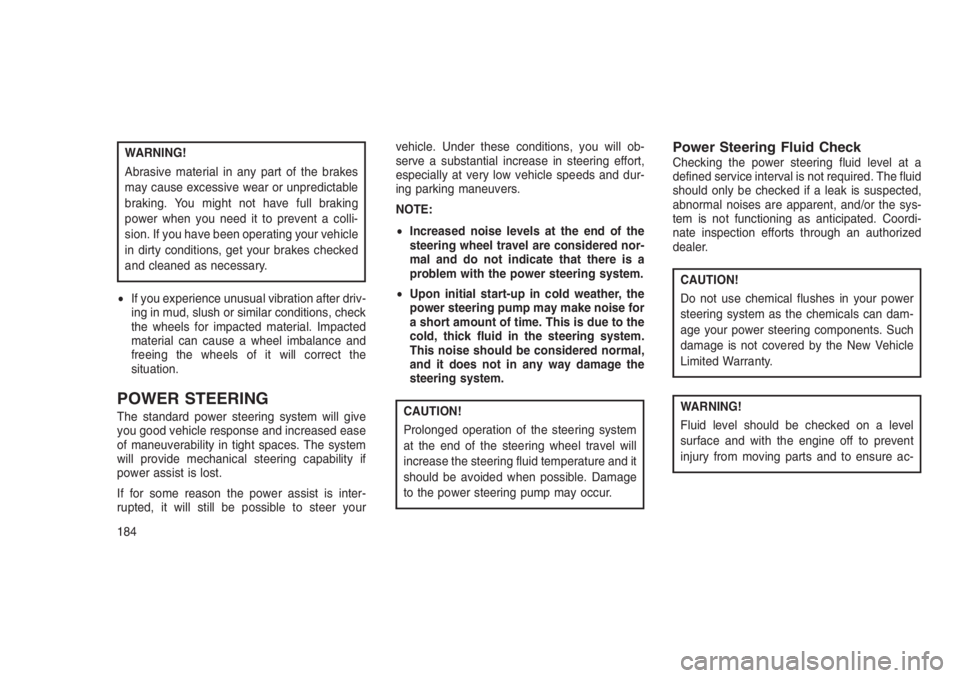
WARNING!
Abrasive material in any part of the brakes
may cause excessive wear or unpredictable
braking. You might not have full braking
power when you need it to prevent a colli-
sion. If you have been operating your vehicle
in dirty conditions, get your brakes checked
and cleaned as necessary.
•If you experience unusual vibration after driv-
ing in mud, slush or similar conditions, check
the wheels for impacted material. Impacted
material can cause a wheel imbalance and
freeing the wheels of it will correct the
situation.
POWER STEERING
The standard power steering system will give
you good vehicle response and increased ease
of maneuverability in tight spaces. The system
will provide mechanical steering capability if
power assist is lost.
If for some reason the power assist is inter-
rupted, it will still be possible to steer yourvehicle. Under these conditions, you will ob-
serve a substantial increase in steering effort,
especially at very low vehicle speeds and dur-
ing parking maneuvers.
NOTE:
•Increased noise levels at the end of the
steering wheel travel are considered nor-
mal and do not indicate that there is a
problem with the power steering system.
•Upon initial start-up in cold weather, the
power steering pump may make noise for
a short amount of time. This is due to the
cold, thick fluid in the steering system.
This noise should be considered normal,
and it does not in any way damage the
steering system.CAUTION!
Prolonged operation of the steering system
at the end of the steering wheel travel will
increase the steering fluid temperature and it
should be avoided when possible. Damage
to the power steering pump may occur.
Power Steering Fluid CheckChecking the power steering fluid level at a
defined service interval is not required. The fluid
should only be checked if a leak is suspected,
abnormal noises are apparent, and/or the sys-
tem is not functioning as anticipated. Coordi-
nate inspection efforts through an authorized
dealer.
CAUTION!
Do not use chemical flushes in your power
steering system as the chemicals can dam-
age your power steering components. Such
damage is not covered by the New Vehicle
Limited Warranty.
WARNING!
Fluid level should be checked on a level
surface and with the engine off to prevent
injury from moving parts and to ensure ac-
184
Page 189 of 332
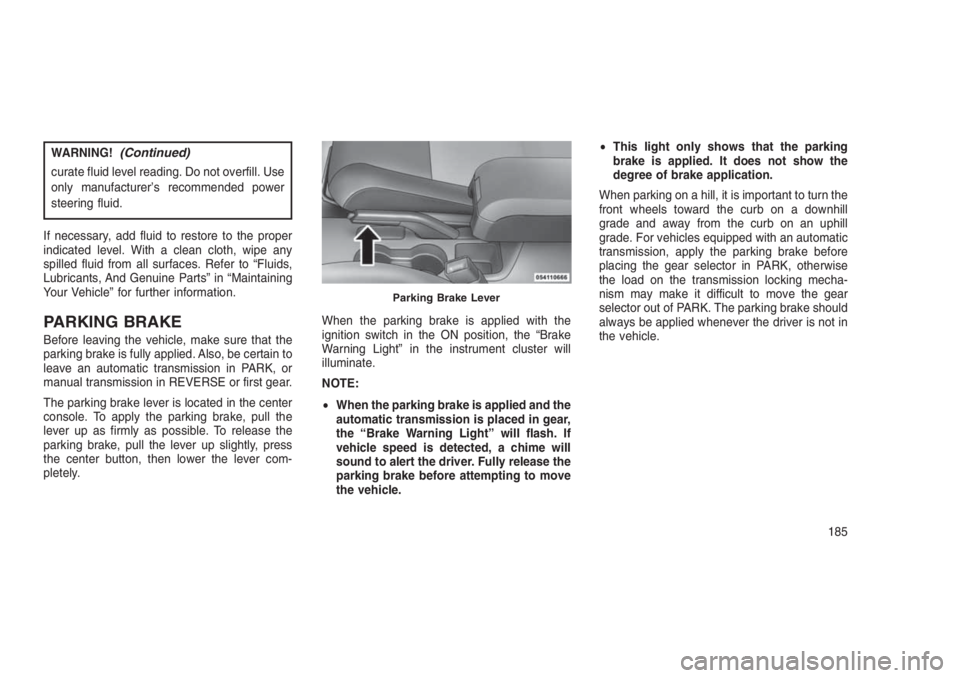
WARNING!(Continued)
curate fluid level reading. Do not overfill. Use
only manufacturer’s recommended power
steering fluid.
If necessary, add fluid to restore to the proper
indicated level. With a clean cloth, wipe any
spilled fluid from all surfaces. Refer to “Fluids,
Lubricants, And Genuine Parts” in “Maintaining
Your Vehicle” for further information.
PARKING BRAKE
Before leaving the vehicle, make sure that the
parking brake is fully applied. Also, be certain to
leave an automatic transmission in PARK, or
manual transmission in REVERSE or first gear.
The parking brake lever is located in the center
console. To apply the parking brake, pull the
lever up as firmly as possible. To release the
parking brake, pull the lever up slightly, press
the center button, then lower the lever com-
pletely.When the parking brake is applied with the
ignition switch in the ON position, the “Brake
Warning Light” in the instrument cluster will
illuminate.
NOTE:
•When the parking brake is applied and the
automatic transmission is placed in gear,
the “Brake Warning Light” will flash. If
vehicle speed is detected, a chime will
sound to alert the driver. Fully release the
parking brake before attempting to move
the vehicle.•This light only shows that the parking
brake is applied. It does not show the
degree of brake application.
When parking on a hill, it is important to turn the
front wheels toward the curb on a downhill
grade and away from the curb on an uphill
grade. For vehicles equipped with an automatic
transmission, apply the parking brake before
placing the gear selector in PARK, otherwise
the load on the transmission locking mecha-
nism may make it difficult to move the gear
selector out of PARK. The parking brake should
always be applied whenever the driver is not in
the vehicle.
Parking Brake Lever
185
Page 190 of 332
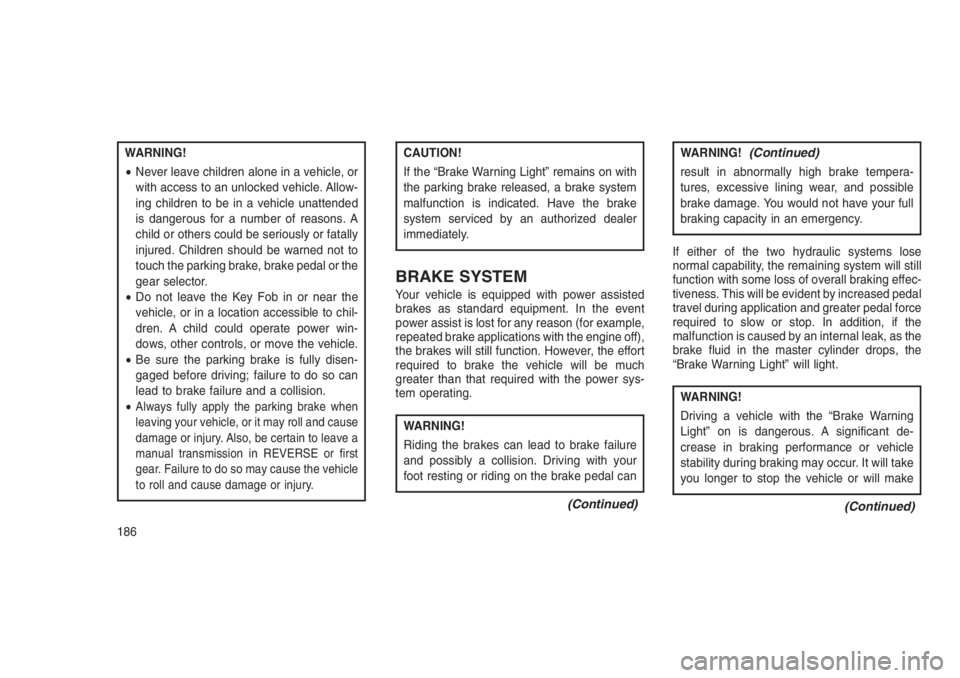
WARNING!
•Never leave children alone in a vehicle, or
with access to an unlocked vehicle. Allow-
ing children to be in a vehicle unattended
is dangerous for a number of reasons. A
child or others could be seriously or fatally
injured. Children should be warned not to
touch the parking brake, brake pedal or the
gear selector.
•Do not leave the Key Fob in or near the
vehicle, or in a location accessible to chil-
dren. A child could operate power win-
dows, other controls, or move the vehicle.
•Be sure the parking brake is fully disen-
gaged before driving; failure to do so can
lead to brake failure and a collision.
•
Always fully apply the parking brake when
leaving your vehicle, or it may roll and cause
damage or injury. Also, be certain to leave a
manual transmission in REVERSE or first
gear. Failure to do so may cause the vehicle
to roll and cause damage or injury.
CAUTION!
If the “Brake Warning Light” remains on with
the parking brake released, a brake system
malfunction is indicated. Have the brake
system serviced by an authorized dealer
immediately.
BRAKE SYSTEM
Your vehicle is equipped with power assisted
brakes as standard equipment. In the event
power assist is lost for any reason (for example,
repeated brake applications with the engine off),
the brakes will still function. However, the effort
required to brake the vehicle will be much
greater than that required with the power sys-
tem operating.
WARNING!
Riding the brakes can lead to brake failure
and possibly a collision. Driving with your
foot resting or riding on the brake pedal can
(Continued)
WARNING!(Continued)
result in abnormally high brake tempera-
tures, excessive lining wear, and possible
brake damage. You would not have your full
braking capacity in an emergency.
If either of the two hydraulic systems lose
normal capability, the remaining system will still
function with some loss of overall braking effec-
tiveness. This will be evident by increased pedal
travel during application and greater pedal force
required to slow or stop. In addition, if the
malfunction is caused by an internal leak, as the
brake fluid in the master cylinder drops, the
“Brake Warning Light” will light.
WARNING!
Driving a vehicle with the “Brake Warning
Light” on is dangerous. A significant de-
crease in braking performance or vehicle
stability during braking may occur. It will take
you longer to stop the vehicle or will make
(Continued)
186